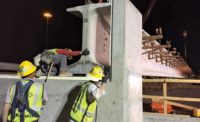This year’s ENR Southwest Top Specialty Contractors rankings include data from 31 firms, with combined regional revenue for 2018 topping $1.8 billion. That’s up from $1.7 billion in 2017. As construction spending increases, companies are struggling to find enough workers to meet demand, according to many firms in the industry.
“Workforce shortages are having significant impacts on the industry,” says Tom Dunn, president, Arizona Builders Alliance. “The Great Recession, the impending retirement of the baby boomer generation, the lack of focus on [construction] training in our educational system and extreme competition from other industries for the same labor market pool have led to increased labor project costs, lowered productivity from less skilled workers, scheduling issues and construction development viability.”
Dunn says his group, which has affiliations with both the Associated Builders and Contractors and the Associated General Contractors, has led regional efforts to provide construction career awareness in high schools, community colleges, universities and the general public to create pathways for careers in construction.
|
Related Link |
Not just content to perform outreach, the Arizona Builders Alliance also operates the third-largest apprenticeship program in the state. The electrical apprenticeship program is a four-year commitment at a cost of $2,200 a year. The group also provides professional development programs that offer diverse courses that cater to the needs of the industry.
Similar apprenticeship programs are scattered throughout the Southwest. The Northern Nevada Apprenticeship Coordinators Association, for example, provides apprenticeship programs for craft laborers, heat and frost insulators, ironworkers, operating engineers, painters and allied trades, sheet metal workers and other related trades.
Despite the need for skilled labor, companies are still working to deliver innovative projects. Rosendin Electric, for example, recently completed work on an expansion and upgrade of Arizona State University’s Combined Heating and Power Facility. The project effectively doubles the available electrical power for the ASU research community microgrid while also increasing steam capacity for heating used by both the research community and the Tempe campus distribution network. The $13-million project, led by McCarthy Building Cos., was completed on time in less than 10 months, with help from Sun Devil Energy LLC, Cleanway Energy and R.G. Vanderwell Engineers.
Upcoming projects will also keep the region’s specialty firms busy, including Balsz School District’s Pat Tillman Middle School, a 70,000-sq-ft facility dedicated to a national sports icon and army veteran who was killed in Afghanistan in 2004. The project is being led by McCarthy Building Cos. and DLR Group.
But projects like these, and a healthy regional economy, mean that expanding the workforce for construction companies must remain a high priority, Dunn says.
“Criminal justice reform and how we can help create pathways to construction careers are being discussed. Protecting Arizona as a right-to-work state is also a priority,” he says.




.jpg?height=200&t=1671747499&width=200)



